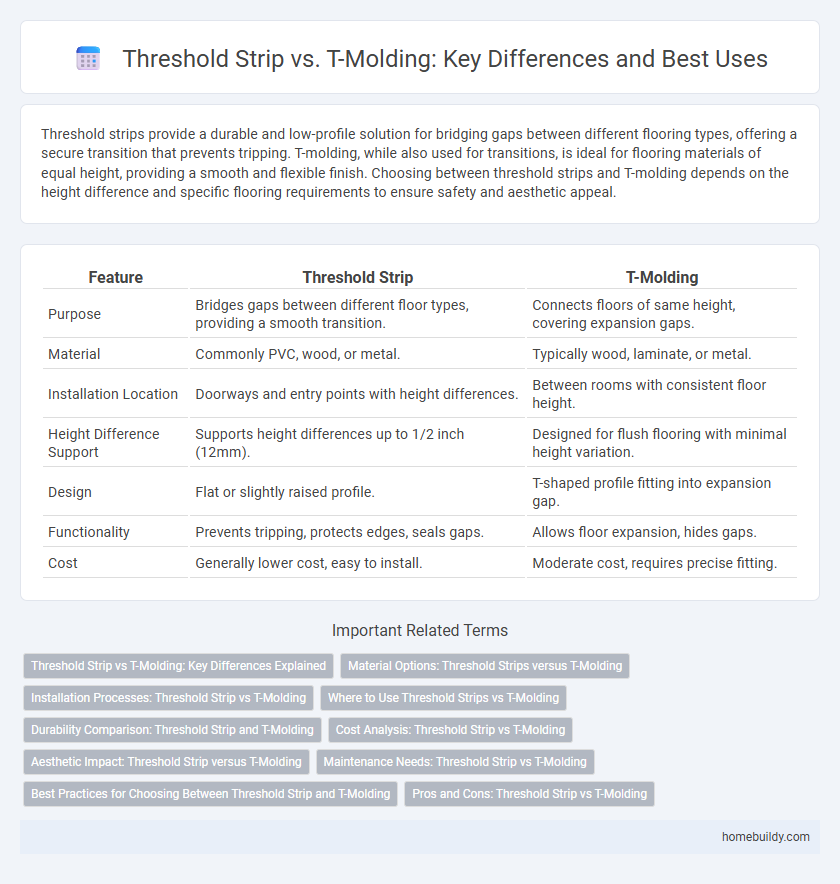Threshold strips provide a durable and low-profile solution for bridging gaps between different flooring types, offering a secure transition that prevents tripping. T-molding, while also used for transitions, is ideal for flooring materials of equal height, providing a smooth and flexible finish. Choosing between threshold strips and T-molding depends on the height difference and specific flooring requirements to ensure safety and aesthetic appeal.
Table of Comparison
| Feature | Threshold Strip | T-Molding |
|---|---|---|
| Purpose | Bridges gaps between different floor types, providing a smooth transition. | Connects floors of same height, covering expansion gaps. |
| Material | Commonly PVC, wood, or metal. | Typically wood, laminate, or metal. |
| Installation Location | Doorways and entry points with height differences. | Between rooms with consistent floor height. |
| Height Difference Support | Supports height differences up to 1/2 inch (12mm). | Designed for flush flooring with minimal height variation. |
| Design | Flat or slightly raised profile. | T-shaped profile fitting into expansion gap. |
| Functionality | Prevents tripping, protects edges, seals gaps. | Allows floor expansion, hides gaps. |
| Cost | Generally lower cost, easy to install. | Moderate cost, requires precise fitting. |
Threshold Strip vs T-Molding: Key Differences Explained
Threshold strips secure flooring transitions at doorways, providing a smooth height difference and preventing tripping hazards, primarily suited for door frames and room entries. T-molding bridges equal-height flooring surfaces, creating seamless transitions between rooms or flooring types without significant elevation changes. The key difference lies in their application: threshold strips accommodate height variations, while T-molding connects floors of the same level.
Material Options: Threshold Strips versus T-Molding
Threshold strips are commonly manufactured from durable materials such as aluminum, rubber, and wood, providing excellent resistance to wear and moisture for doorways. T-molding typically features materials like PVC, laminate, or wood, designed primarily to bridge flooring transitions with a focus on aesthetic appeal rather than heavy-duty protection. Material selection influences functionality, where threshold strips emphasize durability and sealing capabilities, while T-molding prioritizes smooth transitions and design integration.
Installation Processes: Threshold Strip vs T-Molding
Threshold strip installation involves securing the strip directly onto the floor surface, often using adhesive or screws for a stable, flush fit between two floor types. T-molding requires fitting the molding into an expansion gap between floors, typically snapped or pressed into a track embedded in the substrate, allowing for floor movement. The threshold strip's direct fastening offers a simpler, more rigid connection, whereas T-molding accommodates expansion and contraction changes in flooring materials.
Where to Use Threshold Strips vs T-Molding
Threshold strips are ideal for covering transitions between different flooring types of varying heights, such as between hardwood and tile or carpet and laminate, providing a smooth and safe surface. T-molding is best suited for joining floors of the same height, like between two hardwood or laminate floors, creating a seamless and visually appealing connection. Choosing threshold strips is essential in doorways and entry points with height differences, while T-molding fits well in open floor areas requiring minimal transition.
Durability Comparison: Threshold Strip and T-Molding
Threshold strips typically offer superior durability compared to T-molding due to their thicker material composition and secure installation methods, which better withstand heavy foot traffic and impact. Made from robust materials like aluminum, rubber, or vinyl, threshold strips resist wear, moisture, and temperature changes more effectively than the generally thinner, decorative T-molding often crafted from wood or plastic. For long-term performance in high-traffic areas, threshold strips provide a more reliable and enduring solution than T-molding.
Cost Analysis: Threshold Strip vs T-Molding
Threshold strips generally offer a more cost-effective solution compared to T-molding due to lower material and installation expenses. While T-molding provides a seamless transition between differing floor heights, its higher manufacturing costs and complex installation often result in increased overall project budgets. Evaluating the cost-benefit ratio, threshold strips are preferred for budget-conscious flooring projects requiring basic transition functionality.
Aesthetic Impact: Threshold Strip versus T-Molding
Threshold strips provide a seamless transition between different flooring types, offering a clean and discreet appearance that preserves the aesthetic continuity of a room. T-molding, with its more pronounced profile, creates a visible dividing line that can complement or contrast with flooring designs, adding a decorative element to the space. Choosing between threshold strip and T-molding significantly influences the overall visual harmony and style of interior flooring transitions.
Maintenance Needs: Threshold Strip vs T-Molding
Threshold strips typically require less maintenance due to their durable materials and simpler installation, making them resistant to wear and easier to clean. T-molding, often used to bridge gaps between different flooring types, may demand more frequent upkeep because of its complex profile that can trap dirt and is more susceptible to damage or loosening over time. Choosing threshold strips minimizes long-term maintenance efforts in high-traffic areas, whereas T-molding requires regular inspection and occasional adjustment to maintain its appearance and function.
Best Practices for Choosing Between Threshold Strip and T-Molding
Threshold strips provide an effective solution for bridging gaps between different types of flooring, especially when there is a height difference, ensuring a smooth and safe transition. T-molding is ideal for spaces where two floors of the same height meet, offering a sleek design that seamlessly connects areas without creating tripping hazards. Best practices for choosing between threshold strips and T-molding involve assessing floor height differences, durability requirements, and aesthetic preferences to optimize both functionality and visual appeal.
Pros and Cons: Threshold Strip vs T-Molding
Threshold strips provide a clean transition between different floor heights, offering durability and ease of installation, while effectively covering expansion gaps in flooring. T-molding is ideal for joining floors of the same height, creating a smooth, almost invisible seam but may lack the stability needed for uneven surfaces. Threshold strips tend to be more versatile in handling varying floor elevations, whereas T-moldings excel in maintaining aesthetic continuity in level floor transitions.
Threshold strip vs T-molding Infographic

 homebuildy.com
homebuildy.com